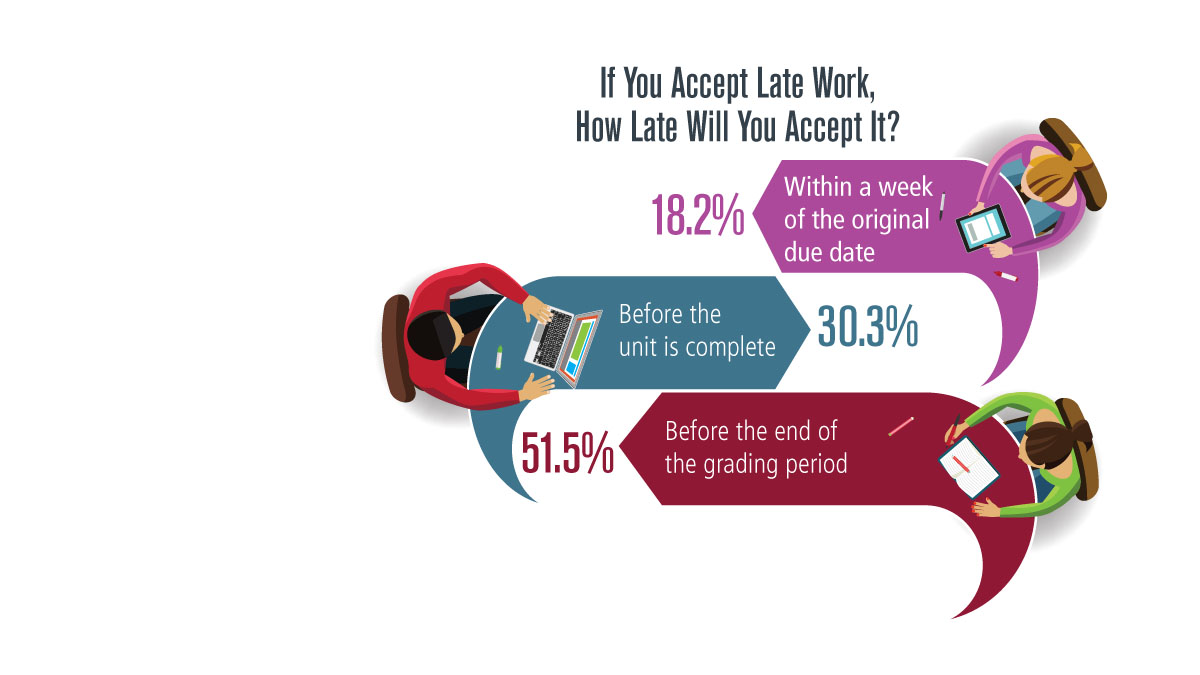NSTA Reports
Organizing for Student Success

Science educators responding to a recent informal NSTA Reports poll were nearly unanimous (94.3%) in reporting they incorporate organizational strategies in their science or STEM (science, technology, engineering, and math) teaching. Twenty percent said they prefer students to use digital calendars and reminders to track assignments, 14.3% post assignments and deadlines on the blackboard/whiteboard, 8.6% have students enter items onto a paper calendar, and 17.1% allow students to choose their own tracking strategies. Several respondents indicated they use a combination of methods, particularly posting assignments in the classroom and on digital calendars.
Only 8.6% said they do not accept late work, 31.4% accept late work for a limited time, and an additional 28.6% only do so for a limited time and they deduct points. Of those accepting late work, 51.5% do so through the end of the grading period, 30.3% until the unit is complete, and 18.2% within a week of the original due date. Nearly 53% say they do not require an explanation for late work; 54.3% said they inform parents when work is not turned in on time.
Here’s what educators say are their favorite strategies for helping students organize and prioritize their work:
Science notebooks are my favorite way to help students get organized: [b]eing able to flip to the next available page, making their own tables and charts to organize information, keeping up with the table of contents, writing the date[s] on pages, learning how to take notes, how to highlight, how to keep their information organized and accessible. (I let students use their science notebooks on tests.)—Educator, Elementary, Middle School, California I start off the week having kids list their classes for each day in their planners so they are ready to record assignments and due dates. I also teach them how to use Google Classroom effectively to keep track of missing work and due dates.—Educator, Middle School, Massachusetts
Varies with the student, [ranging] from tak[ing] a picture of the board with a phone to writ[ing] in a paper planner. —Educator, High School, North Carolina I like to have students set learning goals regularly and revisit then often to see if they are on track. This also gives me talking points for when I conference with students who are not making good progress in class. —Educator, High School, California
No one strategy; I try to have each student develop [their] own strateg(ies).—Educator, Elementary, Nevada
Our school requires them to use a planner. This is on the board. When they enter, they have to update their planner and get their partner to initial it. Additionally, I post due dates and reminders on many whiteboards around the room, as well as online [on a] website. I tell them verbally. —Educator, Middle School, California
I keep a class binder with all notes and assignments that students can go to and get what they are missing, no matter why they missed it. This [has] really cut down on wasted time with each student asking me personally. —Other, Elementary, Middle School, High School, Montana
Take time to show [them] how to make a [date] due calendar...placing due dates two days before they are actually due...helping them plan for unplanned circumstances.—Educator, Institution of Higher Learning, Iowa
Seventh grade: Breaking larger assignments into chunks, discussing how many items need to be completed each day to stay on track, discussing with students what to do when they fall behind.—Educator, Middle School, New York
Originally writing the deadlines on the whiteboard for students to copy down as they prefer. Paper agendas get lost, but they rarely lose their phones. A month before exams, I have students sketch out a study plan allocating time for each course and completing endof-term assignments.—Educator, High School, Manitoba, Canada
Working with them to address issues; helping them to learn various tools to find what works best for them; identifying issues that keep them from focusing on their academic goals, such as time [spent] gaming or with streaming services.—Educator, Institution of Higher Learning, Illinois
[I demonstrate] tools they can use, such as Outlook or Google Calendar, and using them when I schedule meetings with students; creating calendars for the major course assignments in Word and making them available to them in our [learning management system]. (I leave it to the students to add regular weekly assignments like pre-labs, homework.) I encourage students to reach out to me in advance if they are struggling [to meet] a deadline, and will provide them extensions before, but never after the fact. —Educator, Institution of Higher Learning, Massachusetts
I use a binder with a Table of Contents page and [do] a binder check each unit.—Educator, Middle School, Missouri
Using an agenda. Prioritizing to-do lists.—Educator, Middle School, Georgia
Model it myself with calendars, long-term planning, outlining future weeks.—Educator, High School, California
Showing them how to use the agenda (modeling).—Educator, Middle School, North Carolina
Use multiple methods: whiteboard, digital, oral reminders.—Educator, Middle School, Texas
We keep a class calendar [that] lists all assignments and due dates. Students and parents can all subscribe to the same calendar.—Educator, Administrator, Elementary, Middle School, High School, Institution of Higher Learning, Pennsylvania
Weekly hard-copy progress reports on a specific day, with rewards for As and Bs, help a lot.—Educator, High School, North Carolina


